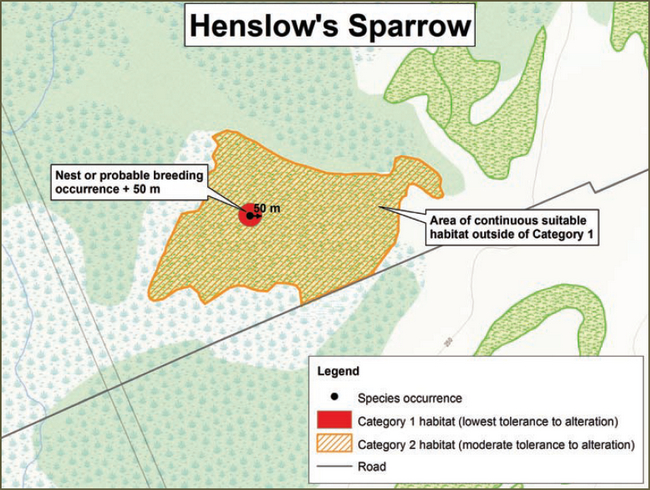Henslow’s Sparrow General Habitat Description
This document is a technical, science-based description of the area of habitat protected for the Henslow’s Sparrow.
A general habitat description is a technical document that provides greater clarity on the area of habitat protected for a species based on the general habitat definition found in the Endangered Species Act, 2007. General habitat protection does not include an area where the species formerly occurred or has the potential to be reintroduced unless existing members of the species depend on that area to carry out their life processes. A general habitat description also indicates how the species' habitat has been categorized, as per the policy "Categorizing and Protecting Habitat Under the Endangered Species Act", and is based on the best scientific information available.
Habitat categorization for Henslow’s Sparrow (Ammodramus henslowii)
Category 1: Nest or probable breeding occurrence and the area within 50 m
Category 2: The area of continuous suitable habitat outside of Category 1
Category 3: Not applicable to this species
Category 1
The nest or probable breeding occurrence and the area within 50 m are included in Category 1 and are considered to have the lowest level of tolerance to alteration.
Henslow’s Sparrows are habitat specialists, requiring large suitable habitat patches for breeding. This species is extremely rare in Ontario. Category 1 is based on probable breeding occurrences because there have been no confirmed breeding occurrences in the province in many years. A probable breeding occurrence is as defined in the Ontario Breeding Bird Atlas (Cadman et al. 2007).
Henslow’s Sparrow nests are constructed of layers of thick thatch or tufts of grass. Studies from the United States suggest that Henslow’s Sparrows defend a breeding territory between of up to 0.7 ha (or approximately the area within 50 m of a nest) (COSEWIC 2011). Henslow’s Sparrows depend upon their defended territories for sensitive life processes including courting, egg laying, incubation, feeding, resting and rearing of young. Nests and defended territories are used daily during the breeding season.
It is important to note that Henslow’s Sparrow nests are rarely identified, due to their cryptic nature. It is inadvisable to search for Henslow’s Sparrow nests as this may inadvertently jeopardize the nesting site/and or offspring. However, if a nest is identified, it and the area within 50 m shall be categorized as Category 1.
Category 2
Category 2 for Henslow’s Sparrow includes the entire continuous area of suitable habitat outside of Category 1. These are areas the species depends on for feeding, rearing of young, resting, dispersal and concealment from predators and is considered to have a moderate tolerance to alteration. It also helps maintain the function of Category 1 habitat.
Henslow’s Sparrow is a grassland-dependent species that has specialized ecological requirements for its breeding ground (COSEWIC 2011). It requires large continuous patches of grassland habitat (Ribic et al. 2009) and is also sensitive to the grassland habitat type. In Ontario, suitable habitat includes, but is not limited to, tallgrass prairie, abandoned fields, ungrazed and lightly grazed pasture, fallow hayfields with high clover and alfalfa content, grassy swales in open farmland, wet meadows, and infrequently mowed fields (Tuninga 2007, Cuddy 1984). Henslow’s Sparrow typically breed in areas where the vegetation is over 30 cm tall and the ground layer has a thick mat of dead plant material from previous years' vegetation (COSEWIC 2011). Areas of standing water or low-laying areas that are wet in the spring appear to be important features to species in Ontario (COSEWIC 2011). Where regional populations are low, as is currently the case in Ontario, unbroken patches of grassland of at least 30 ha and perhaps in excess of 100 ha are believed to be required to support Henslow’s Sparrow populations.
Category 3
Not applicable to this species.
Activities in Henslow’s Sparrow habitat
Activities in general habitat can continue as long as the function of these areas for the species is maintained and individuals of the species are not killed, harmed, or harassed.
Generally compatible:
- Hiking and non-motorized vehicle use on existing recreational trails.
- General yard work such as lawn care and gardening.
- Use of existing roadways including access roads.
Generally not compatible footnote * :
- Development activities that result in significant fragmentation of large tracts of suitable grasslands.
- Activities that alter drainage patterns that will result in long-term or permanent changes to soil moisture and vegetation type.
- Indiscriminate application of pesticides within habitat.
Sample application of the general habitat protection for Henslow’s Sparrow

References
COSEWIC. 2011. COSEWIC Assessment and Status Report on Henslow’s Sparrow Ammodramys Henslowii in Canada. Committee on the Status of Endangered Wildlife in Canada. Ottawa. x + 37pp.
Cadman, M.D., D.A. Sutherland, G.G. Beck, D. Lepage, A.R. Couturier (eds). 2007. Atlas of Breeding Birds of Ontario.2001-2005. Bird Studies Canada, Environment Canada, Ontario Field Ornithologists, Ontario Ministry of Natural Resources and Ontario Nature.706 pp.
Cuddy, D. 1984.Henslow’s Sparrow: guidelines for population monitoring and habitat management in Ontario. Report Prepared for the Wildlife Branch, Ontario Ministry of Natural Resources, Toronto, Ontario.
Ribic, C.A., R.R. Koford, J.R. Herkert, D.H. Johnson, N.D. Niemuth, D.E. Naugle, K.K. Bakker, D.W. Sample, and R.B.
Renfrew. 2009. Area sensitivity in North American grassland birds: Patterns and processes. The Auk 126(2): 233-244.
Tuninga, K. 2007. Henslow’s Sparrow. Pp.552-553 In Cadman, M.D., D.A. Sutherland, G.G. Beck, D. Lepage, A.R. Couturier (eds). 2007. Atlas of Breeding Birds of Ontario. 2001-2005. Bird Studies Canada, Environment Canada, Ontario Field Ornithologists, Ontario Ministry of Natural Resources and Ontario Nature.706 pp.
This general habitat description is available in PDF format upon request. Please email PDF requests to recovery.planning@ontario.ca.
Footnotes
- footnote[*] Back to paragraph If you are considering an activity that may not be compatible with general habitat, please contact your local MNR office for more information.